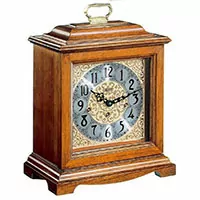What is a Mantel Clock?
At Clockworks, Inc., we receive many questions about different types of clocks. One common inquiry is, "What is a mantel clock?" Knowing the specifics of a mantel clock can help you appreciate its design, functionality, and historical significance. In this detailed article, we will explore what a mantel clock is, its features, history, and why it continues to be a cherished timepiece in many households.
Understanding Mantel Clocks
A mantel clock, as the name implies, is designed to sit on a mantel, shelf, or similar flat surface. Unlike wall clocks or floor-standing grandfather clocks, mantel clocks are compact and portable. They typically feature a decorative case, often crafted from wood, metal, or other premium materials. These clocks serve both as timekeeping devices and as ornamental pieces that enhance a room's aesthetic appeal.
Common Features of Mantel Clocks
Mantel clocks come in various shapes, sizes, and styles, yet they share several common features:
- Portability: Mantel clocks are generally small to medium-sized, making them easy to move and place on different surfaces. Their portability is a key feature distinguishing them from other clock types.
- Decorative Cases: Mantel clock cases often showcase intricate designs, carvings, and inlays. These decorative elements reflect the artistic styles prevalent during the clock's creation.
- Clock Movements: Mantel clocks can feature various types of movements, including mechanical, quartz, and battery-powered. Mechanical mantel clocks, which require winding, are particularly valued for their craftsmanship and historical significance.

The Historical Context of Mantel Clocks
Mantel clocks boast a rich history dating back to the 18th century. They gained popularity during the Rococo period in France, where they were known as "Pendule De Cheminée" (fireplace clocks). These early mantel clocks were often elaborate, with ornate cases made from gilded bronze or other luxurious materials.
Throughout the 19th century, mantel clocks became popular in England and America. During the Victorian era, they became common household items, symbolizing both status and sophistication. Many of these clocks featured intricate wooden cases with carvings and decorative elements reflecting the era's tastes.
Types of Mantel Clocks
There are several types of mantel clocks, each with unique features and styles. Here are some notable types:
- Bracket Clocks: Also known as "table clocks," these often feature a handle on top and were originally designed to be portable. They typically have a rectangular or square case and a spring-driven mechanism.
- Tambour Clocks: Recognizable by their humpbacked shape, tambour clocks, or "Napoleon hat" clocks, became popular in the early 20th century. Their cases often have a curved top and a flat base, making them stable and easy to place on a mantel.
- Lantern Clocks: Originating in the 17th century, lantern clocks feature a distinct design with a brass frame and decorative elements. Although not exclusively mantel clocks, their compact size often leads to their placement on mantels.
- Anniversary Clocks: These clocks, also known as "400-day clocks," feature a torsion pendulum and can run for up to a year on a single winding. Their glass domes and elegant designs make them popular decorative pieces for mantels.

Key Attributes and Functions
Mantel clocks are designed to be both functional and decorative. Some key features include:
- Chimes and Strikes: Many mantel clocks have chime mechanisms that strike the hour and sometimes the half-hour or quarter-hour. These chimes add a pleasant auditory element to the clock's function.
- Pendulums and Escapements: Mechanical mantel clocks often include a pendulum and escapement mechanism, which regulates the clock's movement and ensures accurate timekeeping. These components are often visible through a glass panel in the clock's case.
- Dial and Hands: The clock face, or dial, typically features Roman or Arabic numerals and ornate hands. Some mantel clocks also include additional dials for functions such as moon phases or calendar dates.
Caring for Your Mantel Clock
Proper care and maintenance are essential to keep your mantel clock in good working condition. Here are some tips:
- Regular Winding: If you have a mechanical mantel clock, wind it regularly according to the manufacturer's instructions. Overwinding or underwinding can affect the clock's accuracy.
- Cleaning: Keep the clock clean by dusting it regularly. Use a soft cloth to wipe the case and a gentle brush to clean the dial and hands. Avoid using harsh chemicals or abrasive materials.
- Professional Servicing: Periodically have your mantel clock serviced by a professional clockmaker. Regular servicing can help identify and fix any potential issues before they become major problems.
Conclusion
A mantel clock is more than just a timekeeping device; it is a piece of history and art that can enhance the beauty of any room. Whether you prefer the intricate designs of a Victorian-era bracket clock or the sleek lines of a tambour clock, mantel clocks offer a wide range of styles to suit any taste. Understanding their characteristics, history, and proper care can help you appreciate these beautiful timepieces even more.
For more information or to purchase a mantel clock, visit Clockworks, Inc.. Our team is available for chat support on the website or via email at clockworks@clockworks.com. We are here to assist you with all your clock repair and maintenance needs.
Updated on: 11/12/2024
Thank you!
